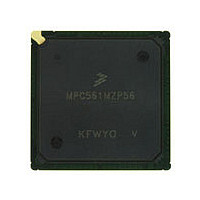MPC561MZP56 Freescale, MPC561MZP56 Datasheet - Page 511

MPC561MZP56
Manufacturer Part Number
MPC561MZP56
Description
Manufacturer
Freescale
Datasheet
1.MPC561MZP56.pdf
(1420 pages)
Specifications of MPC561MZP56
Cpu Family
MPC56x
Device Core
PowerPC
Device Core Size
32b
Frequency (max)
56MHz
Interface Type
QSPI/SCI/SPI/UART
Total Internal Ram Size
32KB
# I/os (max)
56
Number Of Timers - General Purpose
22
Operating Supply Voltage (typ)
2.6/5V
Operating Supply Voltage (max)
2.7/5.25V
Operating Supply Voltage (min)
2.5/4.75V
On-chip Adc
2(32-chx10-bit)
Instruction Set Architecture
RISC
Operating Temp Range
-40C to 125C
Operating Temperature Classification
Automotive
Mounting
Surface Mount
Pin Count
388
Package Type
BGA
Program Memory Type
ROMLess
Program Memory Size
Not Required
Lead Free Status / RoHS Status
Not Compliant
Available stocks
Company
Part Number
Manufacturer
Quantity
Price
Company:
Part Number:
MPC561MZP56
Manufacturer:
Freescale Semiconductor
Quantity:
10 000
Company:
Part Number:
MPC561MZP56R2
Manufacturer:
Freescale Semiconductor
Quantity:
10 000
- Current page: 511 of 1420
- Download datasheet (11Mb)
QADC64E Legacy Mode Operation
If the gate closes before queue 1 completes execution, the current CCW completes execution of queue 1
stops and QADC64E sets the PF1 bit to indicate an incomplete queue. Software can read the CWPQ1 to
determine the last valid conversion in the queue. In this mode, if the gate opens again, execution of queue
1 begins again. The start of queue 1 is always the first CCW in the CCW table.
Since the condition of the gate is only sampled after each conversion during queue execution, closing the
gate for a period less than a conversion time interval does not guarantee the closure will be captured.
13.5.4.4.4
Periodic/Interval Timer Continuous-Scan Mode
The QADC64E includes a dedicated periodic/interval timer for initiating a scan sequence on queue 1
and/or queue 2. Software selects a programmable timer interval ranging from 128 to 128 Kbytes times the
QCLK period in binary multiples. The QCLK period is prescaled down from the IMB3 MCU clock.
When a periodic/interval timer continuous-scan mode is selected for queue 1 and/or queue 2, the timer
begins counting. After the programmed interval elapses, the timer generated trigger event starts the
appropriate queue. Meanwhile, the QADC64E automatically performs the conversions in the queue until
an end-of-queue condition or a pause is encountered. When a pause occurs, the QADC64E waits for the
periodic interval to expire again, then continues with the queue. Once end-of-queue has been detected, the
next trigger event causes queue execution to begin again with the first CCW in the queue.
The periodic/interval timer generates a trigger event whenever the time interval elapses. The trigger event
may cause the queue execution to continue following a pause or queue completion, or may be considered
a trigger overrun. As with all continuous-scan queue operating modes, software action is not needed
between trigger events. Since both queues may be triggered by the periodic/interval timer, see
Section 13.5.6, “Periodic / Interval
Timer” for a summary of periodic/interval timer reset conditions.
Software enables the completion interrupt when using the periodic/interval timer continuous-scan mode.
When the interrupt occurs, the software knows that the periodically collected analog results have just been
taken. The software can use the periodic interrupt to obtain non-analog inputs as well, such as contact
closures, as part of a periodic look at all inputs.
13.5.5
QADC64E Clock (QCLK) Generation
Figure 13-24
is a block diagram of the clock subsystem. The QCLK provides the timing for the A/D
converter state machine which controls the timing of the conversion. The QCLK is also the input to a
17-stage binary divider which implements the periodic/interval timer. To retain the specified analog
conversion accuracy, the QCLK frequency (F
) must be within the tolerance specified in
Appendix F,
QCLK
“Electrical
Characteristics.”
Before using the QADC64E, the software must initialize the prescaler with values that put the QCLK
within the specified range. Though most software applications initialize the prescaler once and do not
change it, write operations to the prescaler fields are permitted.
For software compatibility with earlier versions of QADC64E, the definition of PSL, PSH, and PSA have
been maintained. However, the requirements on minimum time and minimum low time no longer exist.
MPC561/MPC563 Reference Manual, Rev. 1.2
Freescale Semiconductor
13-47
Related parts for MPC561MZP56
Image
Part Number
Description
Manufacturer
Datasheet
Request
R

Part Number:
Description:
MPC5 1K0 5%
Manufacturer:
TE Connectivity
Datasheet:

Part Number:
Description:
MPC5 500R 5%
Manufacturer:
TE Connectivity
Datasheet:

Part Number:
Description:
MPC5 5K0 5%
Manufacturer:
Tyco Electronics
Datasheet:

Part Number:
Description:
MPC5 5R0 5%
Manufacturer:
Tyco Electronics
Datasheet:

Part Number:
Description:
MPC5 50K 5%
Manufacturer:
Tyco Electronics
Datasheet:

Part Number:
Description:
MPC5 1R0 5%
Manufacturer:
Tyco Electronics
Datasheet:

Part Number:
Description:
TOWER ELEVATOR BOARDS HARDWARE
Manufacturer:
Freescale Semiconductor
Datasheet:

Part Number:
Description:
TOWER SERIAL I/O HARDWARE
Manufacturer:
Freescale Semiconductor
Datasheet:

Part Number:
Description:
LCD MODULE FOR TWR SYSTEM
Manufacturer:
Freescale Semiconductor
Datasheet:

Part Number:
Description:
DAUGHTER LCD WVGA I.MX51
Manufacturer:
Freescale Semiconductor
Datasheet:

Part Number:
Description:
TOWER SYSTEM BOARD MPC5125
Manufacturer:
Freescale Semiconductor
Datasheet:












